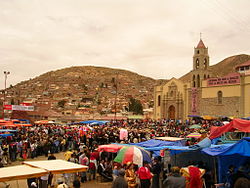Oruro Department
| Department of Oruro | |||
|---|---|---|---|

Santuario de la Virgen del Socavón, Carnaval de Oruro, 2007
|
|||
|
|||
 Location within Bolivia |
|||
| Country |
|
||
| Capital | Oruro | ||
| Provinces | 16 | ||
| Government | |||
| • Governor | Santos Tito (MAS-IPSP) | ||
| Area | |||
| • Total | 53,588 km2 (20,690 sq mi) | ||
| Population (2012 census) | |||
| • Total | 494,178 | ||
| • Density | 9.2/km2 (24/sq mi) | ||
| Time zone | BOT (UTC-4) | ||
| ISO 3166-2 | BO-O | ||
| Languages | Spanish, Quechua, Aymara | ||
| Website | www |
||
Oruro is a department in Bolivia, with an area of 53,588 km². Its capital is the city of Oruro. According to the 2012 census, the Oruro department had a population of 494,178.
The department is divided into 16 provinces which are further subdivided into municipalities and cantons.
Note: Eduardo Abaroa Province (#5) is both north of and south of Sebastián Pagador Province (#6).
The chief executive office of Bolivia departments (since May 2010) is the governor; until then, the office was called the prefect, and until 2006 the prefect was appointed by the President of Bolivia. The current governor, Santos Tito of the Movement for Socialism – Political Instrument for the Sovereignty of the Peoples, was elected on 4 April 2010.
The chief legislative body of the department is the Departmental Legislative Assembly, a body also first elected on 4 April 2010. It consists of 33 members: 16 elected by each of the department's provinces; 16 elected based on proportional representation; and minority indigenous representative selected by the Uru-Chipaya people.
The languages spoken in the department are mainly Spanish, Quechua and Aymara. The following table shows the number of those belonging to the recognized group of speakers.
Coordinates: 18°40′S 67°40′W / 18.667°S 67.667°W
...
Wikipedia


